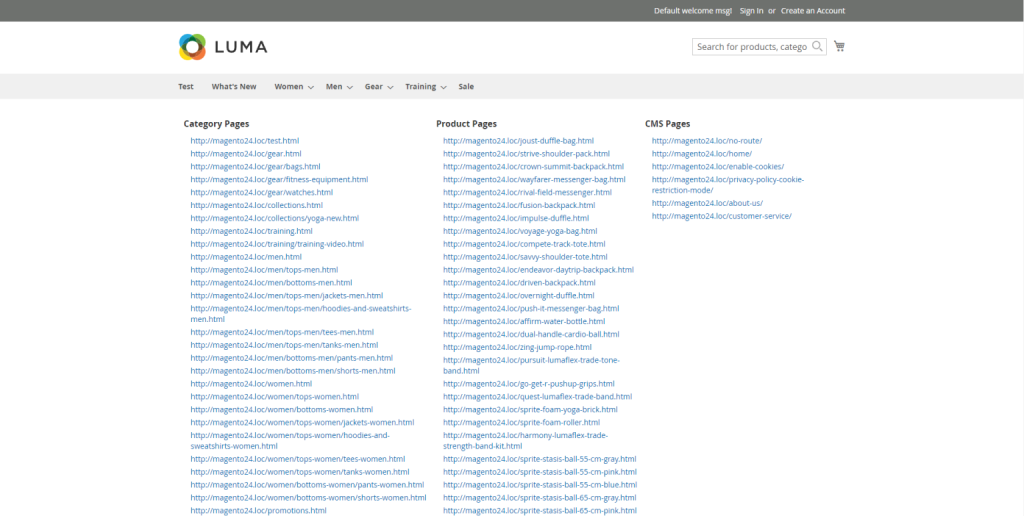
Sitemaps are one of the main elements that can help make your site easy to analyze, index, and identify in search engines. Search engines will read the sitemap to identify new pages, determine how frequently they are updated, and rank them based on the validity of the information they contain. However, when creating a sitemap, people need to know what to use.
In today’s article, we would like to introduce you to Magento 2 XML and HTML sitemaps.
- What is an XML sitemap?
- What is an HTML sitemap?
- The difference between XML and HTML sitemap
- Benefits of sitemaps
- Why is a sitemap a must-have in Magento 2?
An XML sitemap is a site map created with Extensible Markup Language (XML), which contains all URLs and additional metadata for each URL. Metadata includes information about how important the URL is, when it was last updated, how often it is updated, how it is related to other URLs in the site map, etc.
What is an XML sitemap?
An XML sitemap is a site map created with Extensible Markup Language (XML), which contains all URLs and additional metadata for each URL. Metadata includes information about how important the URL is, when it was last updated, how often it is updated, how it is related to other URLs in the site map, etc.

What is an HTML sitemap?
An HTML sitemap is a site map written in HyperText Markup Language that serves as a directory of links or content of pages of your site. Although an HTML sitemap does not directly impact search optimization, it promotes a better user experience. So it’s a good tool that helps search engines like Google to index and provide a better user experience.

The difference between XML and HTML sitemap
The main difference between HTML and XML is that an HTML sitemap can help your customers easily navigate the site and find products quickly. An XML sitemap helps search engines understand your site better; hence the indexing process is much faster, and your site will have a higher ranking, attract more customers, and generate more organic traffic.
To make your website visible on the search result pages, when someone types some keywords on these search engines, you have to let search engines know what is available and ready to be crawled on your site.
Benefits of sitemaps
XML and HTML sitemaps are handy tools that any Magento 2 store should have.
There are some advantages of the HTML sitemap:
- Improving internal links — a site map is a page with a lot of internal links on the site that allows you to go to any page of your store, which is an excellent addition to internal links;
- Improved site navigation – the HTML sitemap is presented in a readable form of a web page. HTML sitemap is an ideal choice to give customers complete looks at what you offer;
- Scan point improvement – because the HTML sitemap is a linked page, it will help search for readers able to find and index pages;
The benefits of the XML sitemap for your store:
- Avoiding Content duplication problems — XML sitemap shows search engines the date and even the time when content is published, which confirms that you are the owner of the content if someone is making a copy without your permission;
- Better website scanning — a sitemap that contains all pages of your site makes it easier for search engines to scan and find these pages, even if some of them do not have internal links;
- Quick page indexing — XML sitemap is the best way to let search engines know of new or modified content that improves indexing and search results;
Why is a sitemap a must-have in Magento 2?
Magento SEO sitemap is just one of many tools for website optimization. You must configure a few simple steps to generate a sitemap automatically to make your website a correct ranking and index.
One of these steps is configuring the frequency of updates to your website. Content updates should be based on new information, product changes, categories, etc. It will improve the system and the user experience.
Another great feature of the sitemap is the order in which the website pages are displayed. Important pages are scanned and indexed first. At the top, some pages are a priority for your users.
In other words, the sitemap can guide your website, which greatly “simplifies life” for search information.
Every sitemap has a different benefit, so it’s up to you to choose which one to use. Besides, it’s also a good idea to use both sitemaps to not only lift the site in ranking but also help the visitors to navigate the websites most conveniently.
We hope that you found this article helpful. If you have any questions, contact us anytime.
GET IN TOUCH